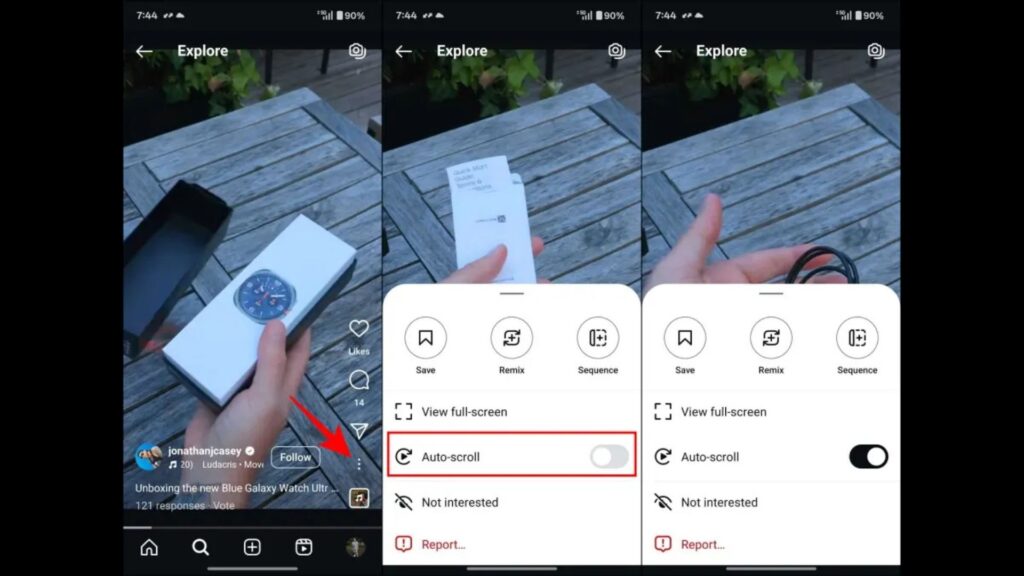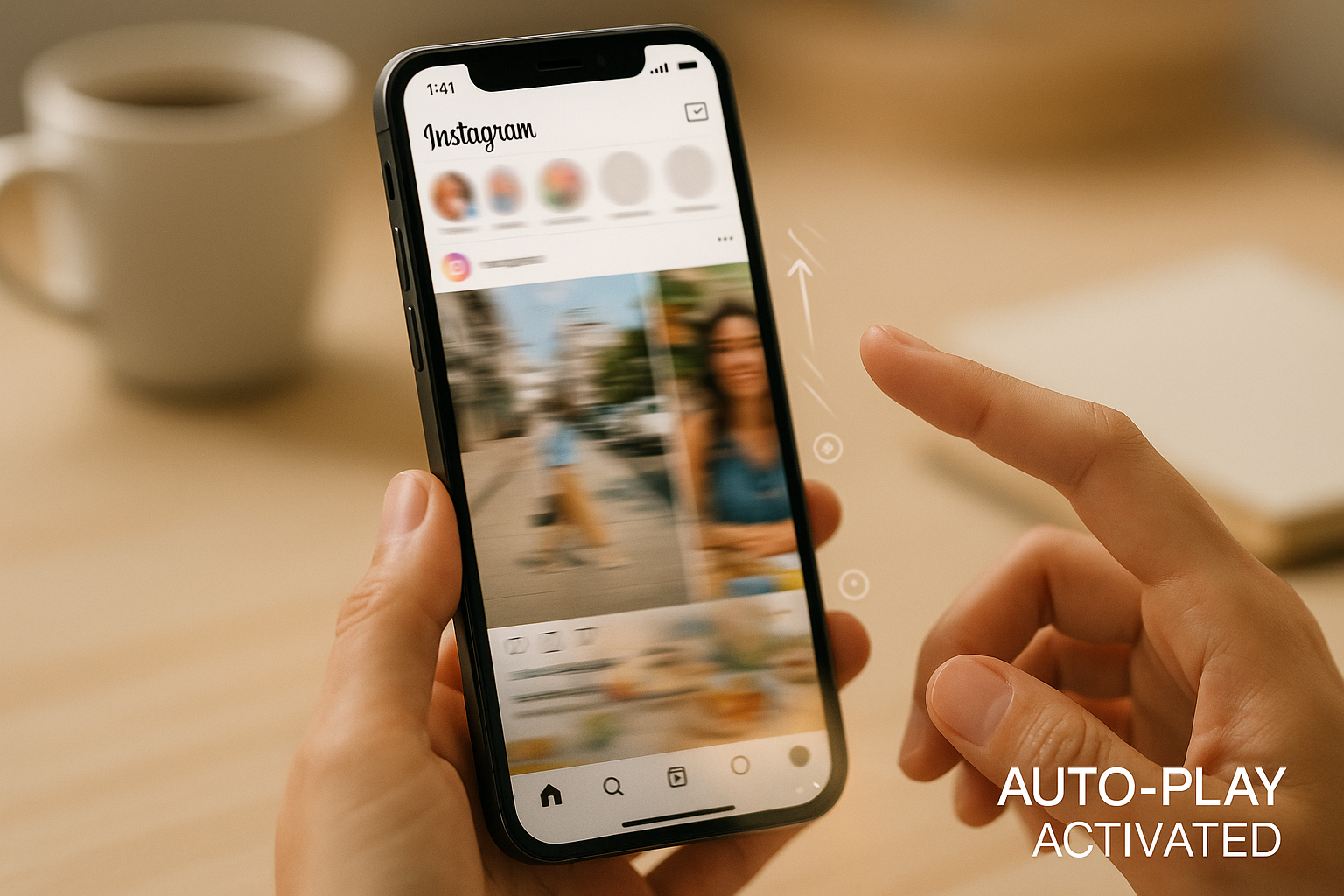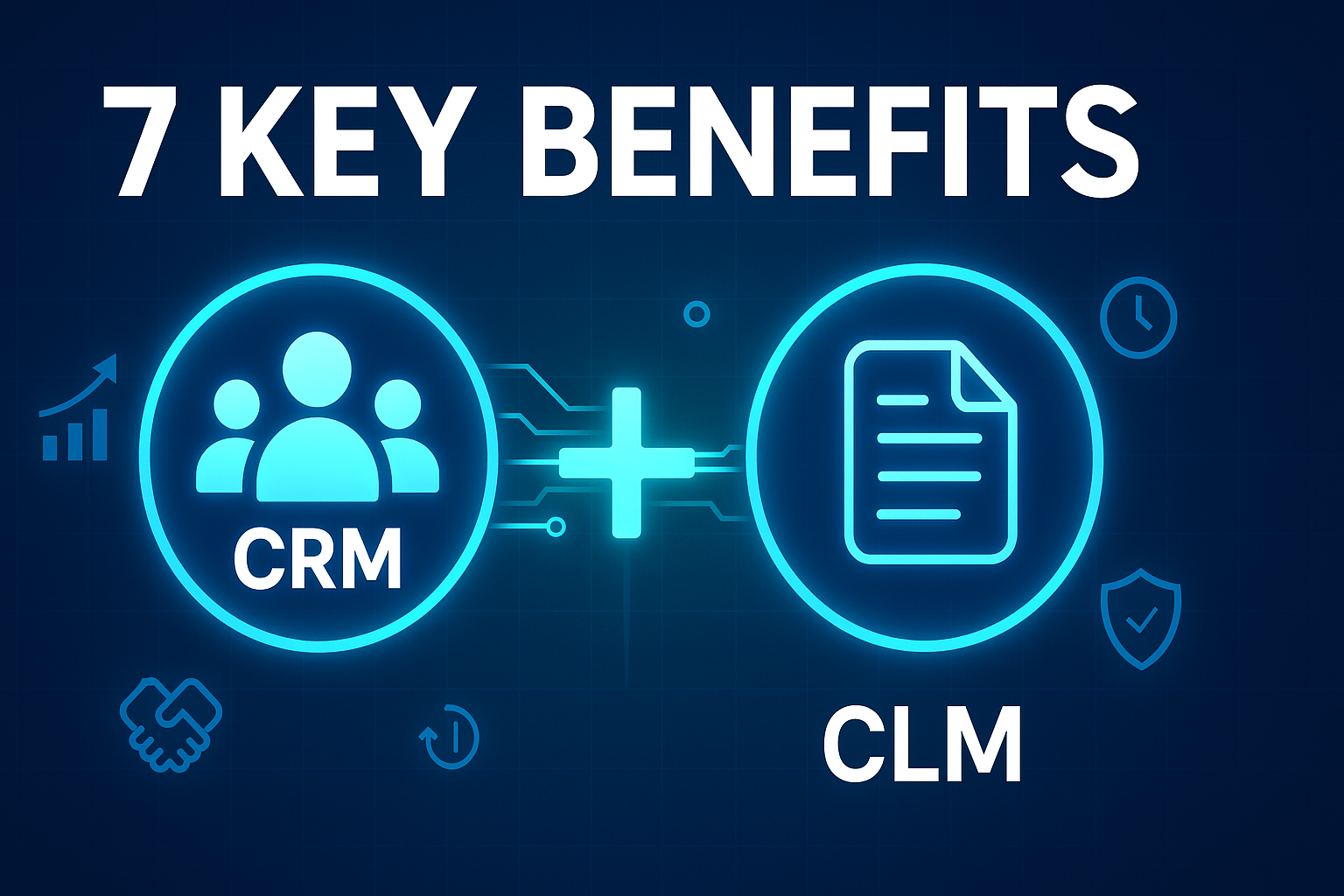July 22nd, 2025 | Updated on July 28th, 2025
Instagram’s relentless pursuit of user engagement has led to another significant experiment that could fundamentally alter how millions of people consume content on the platform.
The social media giant is currently testing an auto-scroll feature for posts, allowing users to sit back and let the algorithm serve up content without the need for manual swiping or tapping.
While this might sound like a minor convenience update, the implications for user behavior, content consumption patterns, and marketing strategies are far more profound than they initially appear.
This development represents Instagram’s latest attempt to compete with the passive consumption models that have made TikTok and YouTube Shorts so addictive and engaging.
As Instagram tests auto-scroll option for posts, creators and brands are left wondering how this shift toward effortless content consumption might impact their carefully crafted engagement strategies and audience relationships.
The timing of this test is particularly significant, coming at a moment when social media platforms are battling for user attention span and time-on-platform metrics.
With users increasingly gravitating toward platforms that require minimal effort to consume content, Instagram’s auto-scroll experiment could signal a major shift in how the platform positions itself in the competitive social media landscape.
This comprehensive analysis explores what this feature means for everyone from casual users to professional content creators, and how the entire Instagram ecosystem might evolve as a result.
What Is the Auto-Scroll Feature on Instagram?
The Instagram auto-scroll feature represents a fundamental departure from the platform’s traditional user-controlled browsing experience.
Instead of requiring users to manually swipe up or tap to advance to the next post in their feed, this new functionality allows content to automatically progress after a predetermined amount of time, creating a hands-free browsing experience similar to watching television or streaming video content.
The feature appears as a simple toggle switch in the post settings, giving users the option to activate automatic scrolling for their main Instagram feed.
Once enabled, posts advance automatically based on algorithms that likely consider factors such as content type, user engagement patterns, and optimal viewing duration for different types of media.
This creates a seamless flow of content that continues indefinitely, requiring no user input beyond the initial activation.
What makes this particularly interesting is that the auto-scroll functionality specifically targets regular posts in the main feed, not Reels, which already have their own auto-play capabilities.
This distinction suggests Instagram is working to create consistency across all content types while recognizing that static posts and carousel content require different consumption patterns than short-form video content.
The technical implementation appears to be sophisticated, likely incorporating machine learning algorithms that adapt scrolling speed based on content complexity, user reading patterns, and historical engagement data.
For image posts, the system probably allows enough time for users to absorb visual information and read captions, while carousel posts might receive extended timing to account for multiple frames of content.
This feature essentially transforms Instagram from an interactive social platform into something more resembling a personalized content channel, where users become passive consumers rather than active participants in their content discovery process.
The psychological shift this represents is significant, moving from intentional content selection to algorithm-driven content delivery.

The user interface changes are minimal but meaningful. The auto-scroll toggle integrates seamlessly into existing settings without disrupting the familiar Instagram experience for users who choose not to activate it.
This careful implementation suggests Instagram is being cautious about maintaining user choice while testing the waters for more passive consumption models.
Early reports from users testing the feature indicate that the scrolling speed feels natural and not rushed, suggesting Instagram has invested considerable effort in calibrating the timing to match natural reading and viewing patterns.
This attention to user experience details will likely be crucial for the feature’s success and broader adoption.
You may also like: Try Free Canva Templates for Instagram Reels
Why Instagram Might Be Testing Auto-Scroll
The strategic reasoning behind Instagram’s auto-scroll experimentation becomes clear when viewed through the lens of current social media consumption trends and competitive pressures.
The rise of TikTok has fundamentally altered user expectations around content consumption, with younger demographics particularly gravitating toward platforms that minimize friction between them and entertaining content.
User behavior analytics across social platforms consistently show that passive consumption models generate longer session times and higher content consumption rates than active browsing models.
When users don’t have to make conscious decisions about advancing to new content, they tend to consume significantly more posts per session, which directly translates to increased advertising inventory and revenue opportunities for the platform.
The attention economy dynamics driving this change reflect broader shifts in how people interact with digital media.
Modern users, particularly those in younger demographics, have developed preferences for seamless, effortless content experiences that don’t require constant decision-making or physical interaction.
This trend has been accelerated by the success of streaming services, short-form video platforms, and gaming experiences that prioritize passive engagement.
Competition with TikTok represents perhaps the most significant driver behind this feature development.
TikTok’s infinite scroll model has proven incredibly effective at capturing and retaining user attention, with users often reporting “losing time” on the platform as they consume content without conscious effort.
Instagram’s auto-scroll feature appears to be a direct response to this competitive threat, attempting to replicate TikTok’s addictive qualities within Instagram’s existing content ecosystem.
The business implications are substantial. Auto-scroll functionality could dramatically increase the number of posts users see per session, which means more opportunities for sponsored content visibility and higher overall advertising effectiveness.
If users consume twice as many posts in the same amount of time, the value of Instagram’s advertising inventory effectively doubles without requiring additional user acquisition.
Algorithm optimization opportunities also play a role in this strategic decision. Auto-scroll provides Instagram’s machine learning systems with more comprehensive data about user preferences, since users can’t skip content as easily.
This forced exposure to a broader range of content types and topics could improve algorithmic content matching and recommendation accuracy over time.
The feature also aligns with Instagram’s broader strategy of increasing time-on-platform metrics, which are crucial for competing with other social media platforms for user attention and advertiser budgets.
In an environment where user attention is increasingly fragmented across multiple platforms, any feature that increases session duration becomes strategically valuable.
Read More: Instagram grid layout ideas for brands
Implications for User Experience
The introduction of auto-scroll functionality carries profound implications for how users interact with Instagram, potentially reshaping the fundamental nature of social media consumption from an active, intentional experience to a more passive, algorithm-driven one.
These changes will likely have both positive and negative effects on different user segments and use cases.
The convenience factor represents the most obvious benefit for users who primarily consume content rather than create it.
Auto-scroll eliminates the physical effort required for continuous browsing, making Instagram consumption possible during activities where manual scrolling might be impractical, such as eating, exercising, or when hands are occupied with other tasks.
This expanded usability could make Instagram more attractive for specific use cases and time periods.
Content discovery could be enhanced through forced exposure to posts that users might otherwise skip.
The algorithm-driven nature of auto-scroll means users will see content they didn’t actively choose, potentially exposing them to new creators, topics, and perspectives they wouldn’t have discovered through manual browsing. This could lead to more diverse content consumption and broader interest development.
However, the passive nature of auto-scroll consumption raises significant concerns about intentional interaction and mindful media consumption.
When users aren’t actively choosing what to view next, they may develop less meaningful connections with content and creators, potentially reducing the social and community aspects that have traditionally defined Instagram’s value proposition.
The psychological effects of completely passive scrolling could be substantial. Manual scrolling requires micro-decisions and brief moments of cognitive engagement that auto-scroll eliminates entirely.
This reduction in active participation might contribute to more mindless consumption patterns and potentially increase the addictive qualities of social media usage.
User control and agency become important considerations when auto-scroll is enabled. While users can presumably disable the feature at any time, the default experience shifts from user-directed to algorithm-directed, which could fundamentally alter how people relate to the platform and their content consumption habits.
The impact on content comprehension and retention is also worth considering. When users actively choose to advance to new content, they’re making a conscious decision that they’ve finished consuming the current post.
Auto-scroll eliminates this natural stopping point, which could reduce the depth of engagement with individual pieces of content and potentially decrease message retention and impact.
Mental health implications deserve serious consideration, as completely passive scrolling could exacerbate existing concerns about social media addiction and mindless consumption.
The reduced friction in content consumption might make it easier for users to lose track of time and consume more content than they intended, potentially contributing to negative mental health outcomes associated with excessive social media use.
How Creators and Brands Should Adapt

The potential widespread adoption of Instagram’s auto-scroll feature necessitates fundamental shifts in content creation and marketing strategies.
Creators and brands who adapt quickly to these changing consumption patterns will have significant advantages in capturing and retaining audience attention in an increasingly passive browsing environment.
Visual impact becomes exponentially more important when users aren’t actively choosing what to view next. Content must immediately capture attention within the first fraction of a second, as auto-scroll gives creators no opportunity to gradually build interest or rely on curiosity to keep viewers engaged.
This means investing in high-quality, visually striking imagery, bold color schemes, and eye-catching design elements that can stop the scroll even when users aren’t actively looking for stopping points.
Caption strategy requires complete reconceptualization for auto-scroll optimization. Long, detailed captions that rely on user investment and reading time become less effective when content advances automatically.
Instead, creators need to front-load the most important information, use larger, more readable fonts when possible, and create captions that deliver value quickly and efficiently.
The importance of the first frame in carousel posts becomes critical in an auto-scroll environment. Since users might not have time to swipe through multiple images before the feed advances, the initial image must carry the full weight of the message and call-to-action.
This might lead to a decline in complex, multi-frame storytelling in favor of more immediate, single-image impact.
Branding elements need to be more prominent and immediately recognizable when users are consuming content passively.
Logo placement, consistent color schemes, and distinctive visual styles become crucial for brand recognition when users aren’t actively paying attention to creator names or handles.
This could lead to more prominent branded elements within content itself.
Call-to-action placement and timing become more challenging in auto-scroll environments. Traditional strategies that rely on building interest throughout a post before presenting a CTA may become less effective.
Instead, creators might need to integrate action-oriented messaging earlier and more prominently in their content to capture user intent before the feed advances.
Content pacing and rhythm take on new importance when creators can’t control how long users spend viewing their content. This might favor simpler, more direct messaging over complex narratives or detailed explanations that require extended viewing time to be effective.
The role of video content within static posts might increase, as moving elements are more likely to capture attention in a passively consumed feed.
This could lead to more creative use of cinemagraphs, subtle animations, or video-first approaches to traditionally static content types.
Testing and optimization strategies must evolve to account for auto-scroll consumption patterns.
Traditional engagement metrics might become less meaningful if users are consuming content more passively, requiring new approaches to measuring content effectiveness and audience response in an auto-scroll environment.
Read More: Instagram reel tips for engagement boost
Could This Change Engagement Metrics?
The introduction of auto-scroll functionality has the potential to dramatically alter Instagram’s engagement landscape, potentially reshaping how likes, comments, shares, and saves function within the platform’s ecosystem.
Understanding these potential changes is crucial for creators and brands who rely on engagement metrics for content strategy and performance measurement.
Passive consumption typically generates different engagement patterns than active browsing.
Users who are letting content scroll automatically might be less likely to interrupt their passive experience to like or comment on posts, potentially leading to decreased overall engagement rates even if content reach and impressions increase.
This shift could fundamentally alter how success is measured on the platform.
However, the opposite effect is also possible. If auto-scroll exposes users to more content that closely matches their interests, they might engage more frequently with posts that truly resonate, leading to higher-quality, more meaningful engagement even if overall engagement volume changes.
The algorithm’s role in selecting which content to show becomes even more critical in this scenario.
Save functionality might become more important in an auto-scroll environment, as users who see interesting content but don’t have time to fully engage with it in the moment might be more likely to save posts for later review.
This could elevate the strategic importance of save-worthy content and change how creators structure their posts to encourage saving behavior.
Comment engagement patterns could shift significantly, as passive scrolling users might be less likely to take the time to compose thoughtful comments.
This could lead to more superficial engagement patterns or, alternatively, to comments becoming more valuable and meaningful when they do occur, since they represent a user actively choosing to interrupt their passive consumption experience.
The timing of engagement becomes more complex when users aren’t controlling content advancement.
Traditional strategies that rely on building engagement over time as posts gain visibility might become less effective if users are seeing content for shorter, algorithm-determined periods rather than user-controlled viewing times.
Story engagement might become relatively more important as users seek more active, intentional content consumption experiences to balance their passive feed scrolling. This could shift strategic focus toward story content and other features that still require user interaction and choice.
Instagram’s algorithm will likely need significant adjustments to optimize for auto-scroll consumption patterns. The platform might need to develop new signals for measuring user interest and engagement when traditional metrics become less reliable indicators of content quality and audience preference.
Influencer marketing metrics and ROI calculations will require reevaluation if engagement patterns change significantly. Brands investing in influencer partnerships might need to develop new success metrics that account for passive consumption patterns and changed engagement behaviors.
Preparing for the Future: Best Practices for Auto-Scroll Era
As Instagram continues testing its auto-scroll functionality, forward-thinking creators and brands should begin adapting their content strategies now to maximize effectiveness in a potentially more passive consumption environment.
The transition to auto-scroll, if implemented globally, won’t happen overnight, giving strategic content creators time to experiment and optimize their approaches.
Visual storytelling must become more immediate and impactful to succeed in auto-scroll environments.
This means developing design skills that create instant visual hierarchy, using bold typography that remains readable at smaller sizes, and creating compositions that communicate key messages within seconds rather than requiring extended viewing time.
Consider investing in design tools and training that enable more sophisticated visual content creation.
Content batching and series development strategies should evolve to account for users who might encounter your content more frequently due to increased consumption rates.
Creating cohesive visual themes and messaging across multiple posts becomes more important when users are seeing larger volumes of content in shorter time periods. This consistency helps build brand recognition even in passive consumption scenarios.
Platform diversification becomes more critical as Instagram’s consumption patterns change. Creators and brands should ensure they’re not overly dependent on a single platform’s algorithm and engagement patterns.
Developing strong presences on multiple platforms provides insurance against significant changes to any single platform’s user experience or algorithm.
Analytics interpretation skills need to evolve to account for changing engagement patterns and consumption behaviors.
Traditional metrics might become less meaningful, requiring content creators to develop new ways of measuring success and audience connection. This might involve focusing more on reach, impressions, and profile visits rather than traditional engagement metrics.
Community building strategies should emphasize creating strong connections that transcend passive consumption patterns.
This might involve more direct communication through comments, DMs, and other interactive features that require active user participation.
Building email lists, creating private communities, or developing other owned media channels becomes more valuable when social media consumption becomes more passive.
Content repurposing and cross-platform adaptation strategies should account for different consumption patterns across platforms. Content created for Instagram’s auto-scroll environment might need different approaches when shared on platforms that still emphasize active user engagement and interaction.
Timing and frequency strategies require reconsideration when users are potentially consuming content at higher rates. This might mean posting more frequently to maintain visibility or, conversely, focusing on higher-quality, less frequent content that can compete for attention in a more crowded consumption environment.
Collaboration and networking with other creators might become more important for maintaining audience attention and engagement when individual content competes in a more passive consumption environment. Cross-promotion, collaborative content, and creator partnerships could help break through the noise of auto-scrolled feeds.
Read More: Instagram SEO tips for better visibility
Conclusion
Instagram’s experimentation with auto-scroll functionality represents more than just a convenience feature—it signals a fundamental shift toward passive consumption models that could reshape how we think about social media engagement, content creation, and digital marketing strategy.
As the platform moves closer to the seamless, effortless content delivery that has made TikTok so successful, creators and brands must prepare for a future where capturing attention becomes even more challenging and critically important.
The implications extend far beyond simple user experience improvements. Auto-scroll could fundamentally alter the creator economy, changing how influence is built, how brands connect with audiences, and how meaningful connections are fostered in digital spaces.
The shift from active, intentional content consumption to passive, algorithm-driven feeds represents a broader trend toward convenience and automation in digital experiences.
For content creators, the message is clear: adaptation is not optional. The most successful creators will be those who begin experimenting now with more visually impactful, immediately engaging content that can capture attention in increasingly passive consumption environments.
This means investing in design skills, rethinking content strategy, and developing new metrics for measuring success in a changing landscape.
Brands face similar challenges and opportunities. The potential for increased content consumption rates could provide more opportunities for brand visibility, but only for those who adapt their creative strategies to succeed in auto-scroll environments.
Traditional marketing approaches that rely on building interest over time may become less effective than strategies that create immediate impact and recognition.
The broader implications for user behavior and digital wellness deserve serious consideration as these features develop.
While auto-scroll might provide convenience and improved content discovery, it also represents another step toward more addictive, harder-to-control social media experiences.
The balance between user engagement and user welfare will likely become an increasingly important consideration for platforms and policymakers alike.
As Instagram continues testing this feature and potentially rolls it out globally, the social media landscape will continue evolving toward more passive, algorithm-driven consumption models.
The creators, brands, and marketers who recognize this trend early and adapt their strategies accordingly will be best positioned to thrive in this new environment.
The future of social media is becoming more automated, more algorithm-dependent, and more focused on effortless consumption.
Whether this represents positive progress toward better user experiences or concerning movement toward more addictive digital habits remains to be seen. What’s certain is that change is coming, and preparation starts now.
Start experimenting with more visually compelling, immediately engaging content today.
Test different approaches to capturing attention quickly, invest in design capabilities that create stopping power, and begin developing content strategies that work effectively in both active and passive consumption environments.
The creators who begin adapting now will have significant advantages when auto-scroll becomes the norm rather than the exception.







